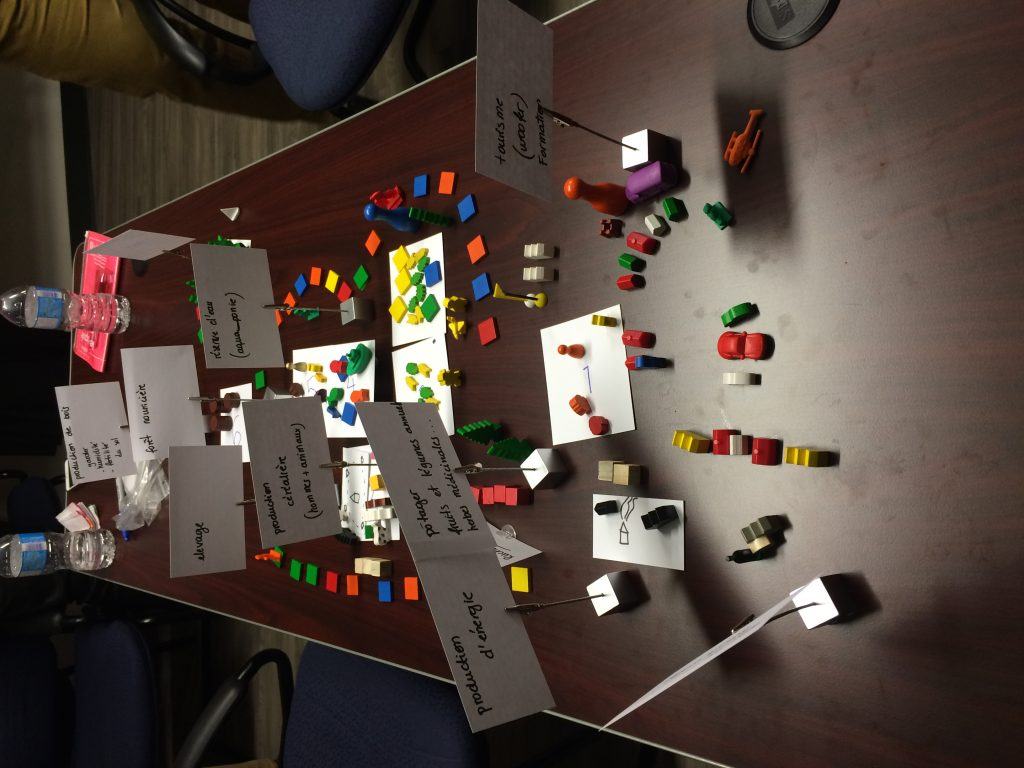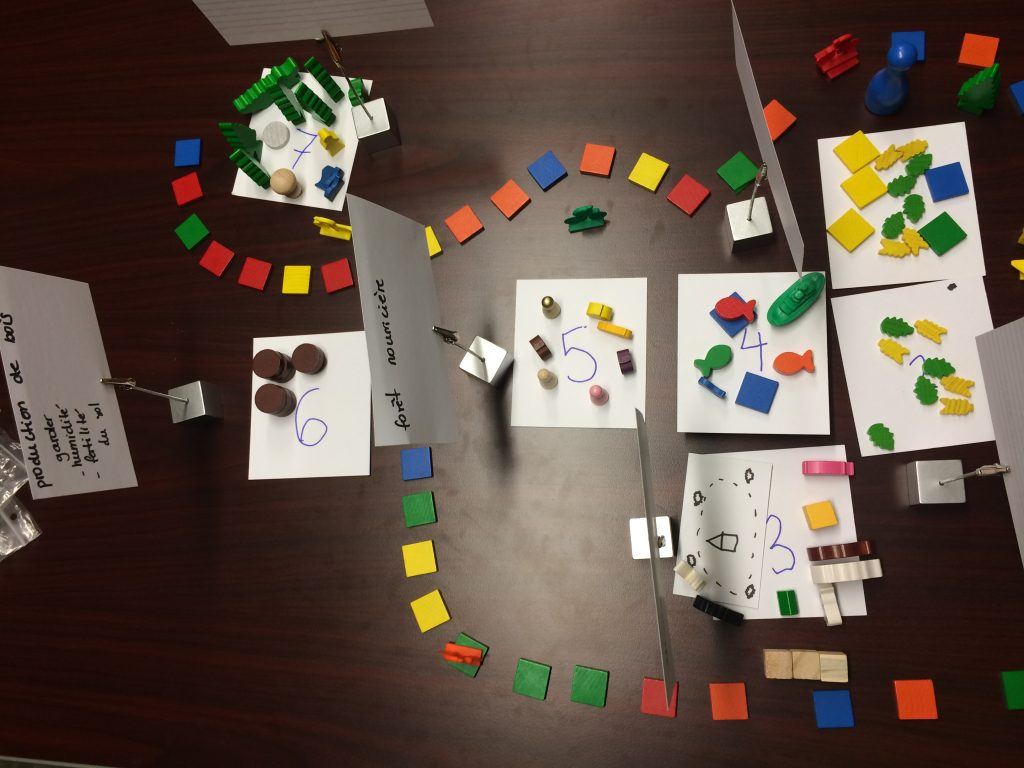On 09 June 2016, we organized a workshop to reflect together on the combination of technology and agriculture. Following this workshop, André Fortin gave a summary for those who were unable to be there.
OUTCOMES OF THE THINKING DESIGN WORKSHOP
How to bring technology and agriculture closer together
André Fortin, June 13, 2016
Date: June 9, 2016, from 9 am to 4:30 pm
Location: Chantier de l’économie sociale – 1431 rue Fullum
Facilitator: André Fortin, creative facilitation and social innovation consultant
Objectives
Identify key issues related to agriculture and technology.
Develop portraits of the main actors: farmers, agronomists, agricultural technology professionals, digital technology developers.
Prototype an ideal model of sustainable agriculture that uses technology.
Converse on promising avenues and ways to bring the two sectors closer together (agriculture and technology).
WHAT ARE THE KEY ELEMENTS IN 2016?
POLITICAL AND ECONOMIC COMPONENT
The countries producing agricultural products have no decision-making power.
The focus of the food industry is the profit governed by the stock market. It is also the stock market that fixes prices (ex: cocoa) and this has great repercussions on the farmers.
Experts in the field are trained by industry and heavily influenced by existing lobbyists.
In this field, it’s the political dimension that has the upper hand over all other considerations (eg COP21).
Local consumption is emerging. People care about it.
The theme of biodiversity is increasingly present in mass discourses.
There is a lack of support from the government in relation to certain policies (eg no policy is put in place in relation to overconsumption or waste).
There is a shortage in the agricultural sector which causes an imbalance.
You have to be big to survive. This causes farms to merge with each other.
Organic food is more accessible.
There is an awakening on grassroots initiatives. Parallel practices are being developed to propose alternatives.
SOCIAL AND ENVIRONMENTAL COMPONENT
Influence of climate change. Everybody feels the effects (drought, shifted production periods)
It lacks spaces and land to cultivate. Lands are more and more privatized.
There are education campaigns for recycling and we are beginning to see corrective measures to force people to participate.
Increased pollution and scarcity of several natural resources.
We see the abandonment of agricultural jobs. This is not very fashionable.
Real awareness of the importance of changing our lifestyles. We get hammer blows on the head.
There is disarray in relation to the problems that can, on the other hand, be mobilizing.
More denunciation about bad practices, more information communicated.
Recrudescence of vegetarianism, or of citizen initiatives promoting it.
We are looking for alternatives, especially for chemical pesticides.
There is a disconnection with the land, a lack of direct contact or agricultural experiences.
The sustainable development movement has more weight than before.
Consumption habits do not move fast enough as the urgency to act.
We feel guilty if we do not adopt good food consumption practices.
We are beginning to have a systemic vision of agriculture, where several elements are related to this issue. The basic ecosystem is being studied deeply.
CULTURAL AND TECHNOLOGICAL COMPONENT
Meteoric rise of the automation and robotization processes (dairy farms) and certain technologies such as drones.
Development and beginning of the recognition of permaculture and passive technologies.
Lack of technology optimization: a lot needs to be done on this issue.
We see the development of local digital applications and searching solutions that are adapted locally to reduce pollution and make food production more efficient.
We continue on the export-oriented model.
Ignorance of fair agricultural practices. On the other hand, some know-how craft are accessible in open-source mode, which allows a decompartmentalization of knowledge.
Creation of a sense of belonging to certain chefs who advocate healthy eating habits and are highly publicized.
WHAT ARE THE KEY ELEMENTS IN 2025?
The sharing economy will become the norm.
More poverty in the world, therefore a malnutrition for the majority
The water shortage issue.
Agriculture-related jobs are going to be fashionable. There will be a similar trigger to cigarette smoking (within a few years the cigarette has become a public health problem and campaigns intended to reduce its use have proliferated).
There will be tension between the development of grassroots initiatives and the notion of control of certain organizations or lobbies by the proliferation of genetic engineering.
The problem of programmed obsolescence will disappear.
We will increase our ability to produce technologies that allow meaningful contributions.
Changes in our eating habits are expected given the environmental component and the number of people on Earth. Some education campaigns will be deployed to promote this.
The deployed system will collapse. This will allow the creation of new, more sustainable systems.
Some government measures are expected, for example, to develop taxes to reduce waste.
The contribution of agriculture to health and to our lifestyles will be increasingly recognized.
PROTOTYPING ACTIVITY
Two teams have developed a prototype of an IDEAL MODEL OF SUSTAINABLE AGRICULTURE INTEGRATING TECHNOLOGIES. For each prototype, key principles emerge. We will publish one here:


Our system is designed to be as self-sufficient as possible and is based on the principles of permaculture.
ZONE 1 is the one that needs more human interactions (vegetable gardens, fruits and vegetables).
There is also compost, food processing and energy production.
We also have an area, a hostel to accommodate tourists, but not just tourists, woofers too and to offer trainings. That gives us varied income.
You can go cycling on the spot.
We have hives for our pollinators that cover the territory.
In ZONE 2, cereals are cultivated for humans and animals.
ZONE 3 is where our animals will move during the year in the fields (to work the land, fertilize, and finish eating roots). We also have greenhouses where the flowers are grown to attract more pollinators.
ZONE 4 is raised to have water in a high level in order to use it by gravity and without energy. There may also be aquapony.
ZONE 5 is further away. So the further away we go, the less we visit these areas and the more they are autonomous. ZONE 5 is the food forest that is self-fertile. It’s planned that the food forest will within 25 years be able to offer fruits, nuts, herbs, and vines.
ZONE 6 produces wood for construction, heating, and especially making mulch to cover our fields in order to limit the evaporation and prevent the weeds to grow, and to increase the fertility of the soil.
ZONE 7 occupies almost a third of the territory. It is an untouched area that will inspire us to see what grows naturally and how we can learn from this ecosystem.
We thank all the participants for attending this workshop. We plan to organize a workshop in the course of the first quarter of 2017, enriched by the information we have collected in Cameroon.